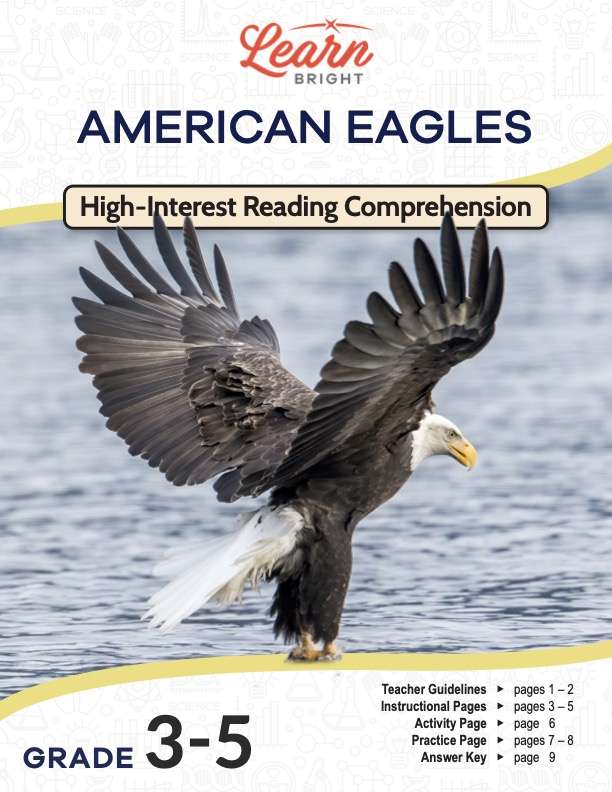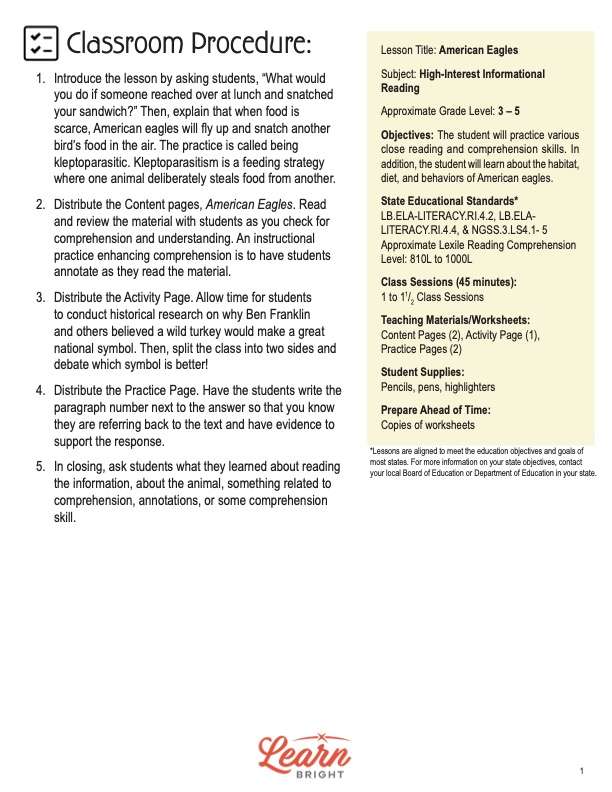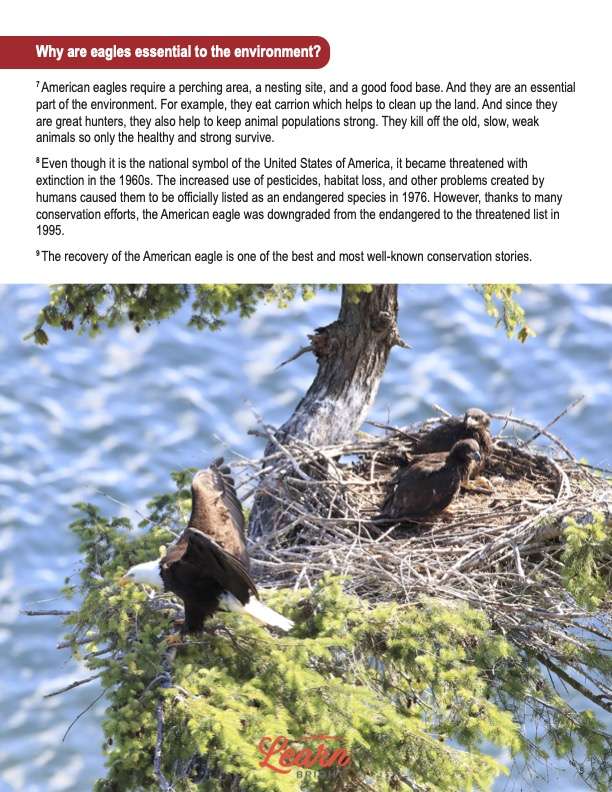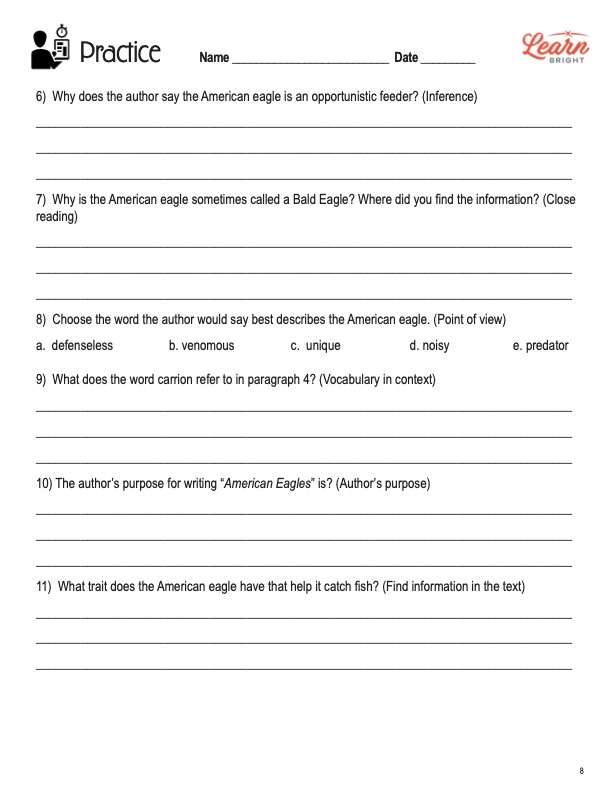Description
What our American Eagles lesson plan includes
Lesson Objectives and Overview: American Eagles is a high-interest reading comprehension lesson plan. As such, students will practice various close reading and comprehension skills. In addition, they will learn about the eagle’s habitat, diet, and behaviors. This lesson is for students in 3rd grade, 4th grade, and 5th grade.
Classroom Procedure
Every lesson plan provides you with a classroom procedure page that outlines a step-by-step guide to follow. You do not have to follow the guide exactly. The guide helps you organize the lesson and details when to hand out worksheets. It also lists information in the yellow box that you might find useful. You will find the lesson objectives, state standards, and number of class sessions the lesson should take to complete in this area. In addition, it describes the supplies you will need as well as what and how you need to prepare beforehand.
Teacher Notes
The teacher notes page provides an extra paragraph of information to help guide the lesson and remind you what to focus on. It explains that you can teach this lesson in a whole-class setting or to an independent, small group as an activity. The blank lines on this page are available for you to write out thoughts and ideas you have as you prepare the lesson.
AMERICAN EAGLES LESSON PLAN CONTENT PAGES
American Eagles
The American Eagles lesson plan contains three pages of content. It begins by providing a box of basic information. Eagles are avians from North America and Canada. Their diet includes fish, small mammals, and carrion. They can live up to 30 years in the wild.
An American eagle has a dark brown body, wings, and a white head and tail. It has bright yellow feet and a large, hooked bill. While people like to call it an American eagle because it is the national bird of the United States of America, it is most often called a bald eagle. Why exactly do we call it a bald eagle if it has white feathers on its head? In this case, the word bald does not mean without any hair (or feathers) on the head. In Old English, balde meant white and referred to feathers. Over time the ‘e’ was dropped from the word.
American eagles fly high in the sky or perch in tall trees near rivers or lakes. They live near large inland lakes and rivers that have abundant fish. In general, they choose the tops of trees to build their nests. Each year they enlarge their nests, and some nests are as wide as 10 feet across and weigh up to 1,000 pounds! American eagles can have a single nest, or they can have several in their territory.
Female bald eagles are larger than the males and weigh around 10 to 14 pounds with a 7-foot wingspan. Males weigh approximately 8 to 10 pounds and have up to a 6-foot wingspan. Once a female meets her mate, they often remain paired for life. Typically, bald eagles will lay one to three eggs once a year. It takes the eggs about 35 days to hatch. Baby eagles or eaglets learn to fly within the first three months of their life. A month after that, they go out to live on their own.
What They Eat and Other Interesting Facts
Using their sharp talons, American eagles snatch fish out of the water to feed on. The undersides of their feet are coarse or rough, so the fish will not slip out of their grasp. Fish is their staple food, which is why the eagles live near lakes, rivers, and marshes. They also feed on ducks, waterfowl, turtles, rabbits, snakes, and other small animals. American eagles will also eat carrion, the decaying flesh of dead animals. In addition, these majestic birds are predators and scavengers, which means they are opportunistic feeders.
American eagles glide around 20 to 40 miles per hour. American eagles are even faster when hunting prey. When this eagle dives into the water to grab a fish, it can travel up to 100 miles per hour. And it can swim if it needs to by using an overhand movement of their wings, which looks a lot like the butterfly stroke. The largest population of bald eagles lives in Alaska. Hawai’i is the only state in which these beautiful creatures do not live.
Year after year, American eagles return to their nest, and just like people, they like to make additions and improvements. Many will add twigs and branches each year. One nest someone found had been used for over 34 years and weighed over two tons—that’s almost 4,000 pounds!
Why They Are Important
American eagles require a perching area, a nesting site, and a good food base. And they are an essential part of the environment. For example, they eat carrion, which helps to clean up the land. And since they are great hunters, they also help to keep animal populations strong. They kill off the old, slow, weak animals so only the healthy and strong survive.
Even though it is the national symbol of the United States of America, it became threatened with extinction in the 1960s. The increased use of pesticides, habitat loss, and other problems created by humans caused them to be officially listed as an endangered species in 1976. However, thanks to many conservation efforts, the bald eagle was downgraded from the endangered to the threatened list in 1995. The recovery of the American eagle is one of the best and most well-known conservation stories.
AMERICAN EAGLES LESSON PLAN WORKSHEETS
The American Eagles lesson plan includes two worksheets: an activity worksheet and a practice worksheet. Each one will help students solidify their grasp of the material they learned throughout the lesson. You can refer to the classroom procedure guidelines to know when to hand out each worksheet.
NATIONAL BIRD DEBATE ACTIVITY WORKSHEET
For the activity, students will read a short paragraph on the debate of which bird should represent the nation. Ben Franklin wanted the wild turkey to be the national symbol while John Adams and Thomas Jefferson preferred the bald eagle. Students will examine the nature of both of these birds and decide whether they would have sided with Ben Franklin or John Adams and Thomas Jefferson. They will explain their choice by discussing the characteristics of the two birds and what makes them good national symbols.
AMERICAN EAGLES PRACTICE WORKSHEET
The practice worksheet lists 11 questions based on the content. These questions all relate to the content pages, so students will need to refer to them often for the answers. In addition, each question provides which reading tool the question corresponds to, such as text feature, vocabulary, or comprehension.
Worksheet Answer Keys
At the end of the lesson plan document is an answer key for the practice worksheet. The correct answers are all in red to make it easier for you to compare them with students’ responses. If you choose to administer the lesson pages to your students via PDF, you will need to save a new file that omits these pages. Otherwise, you can simply print out the applicable pages and keep these as reference for yourself when grading assignments.










